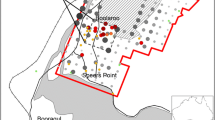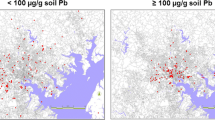Abstract
Despite a general reduction in blood lead levels in children after lead was banned in gasoline and paint, lead poisoning remains an important health problem in many older urban areas. One factor that increases risk in these places is the high levels of lead in certain residential areas. A major intervention study found that reducing lead levels in urban soils results in a reduction in exposed children’s blood lead levels. Removing lead from inner-city soils or reducing exposures to lead-contaminated soils typically is expensive, technologically challenging, or beyond the ability of low-income households to undertake. This project, in conjunction with residents and community-based institutions, developed a series of in situ, low-cost, low-technology measures that worked to reduce the exposure to lead-contaminated soils in one Boston, Massachusetts, neighborhood. The project demonstrated several important results. Government, universities, residents, and community based organizations can work together effectively to reduce exposures to lead in soil. Lead-contaminated soil can be mitigated at a fraction of the cost of conventional methods in ways that increase the ability of residents, community health centers, and others to have a positive impact on their neighborhoods. A lead-safe yard program can be replicated and institutionalized by municipal home de-leading programs and other community organizations.
Similar content being viewed by others
References
Federal Interagency Forum on Child and Family Statistics. America’s Children: Key National Indicators of Well-Being. Washington, DC: US Government Printing Office; 1998.
Centers for Disease Control and Prevention. Screening Young Children for Lead Poisoning: Guidance for State and Local Public Health Officials. Atlanta, GA: Centers for Disease Control and Prevention; 1997.
Environmental Defense Fund. Legacy of Lead: America’s Continuing Epidemic of Childhood Lead Poisoning. Washington, DC: Environmental Defense Fund; 1990.
Weitzman M, Aschengrau A, Bellinger D, Jones, R, Hamlin JS, Beiser A. Lead-contaminated soil abatement and urban children’s blood lead levels. JAMA. 1993;269(13): 1647–1654.
Mielke HW, Reagan P. Soil is an important pathway of human lead exposure. Environ Health Perspec. 1998;106:217–229.
Murgueytio AM, Evans RG, Sterling DA, Clardy SA, Shadel BN, Clements BW. The relationship between lead mining and blood lead levels in children. Arch Environ Health. 1998;53(6):414–423.
Stanek EJ, Calabrese E. Soil ingestion estimates for use in situ evaluation based on the best tracer method. Hum Ecol Risk Assess. 1995;1(2):133–156.
Fergusson JE, Forbes EA, Schroeder RJ, Ryan DE. Lead: petrol lead in the environment and its contribution to human blood lead levels. Sci Total Environ. 1986;50:1–54.
Aschengrau A, Beiser A, Bellinger D, Copenhafer D, Weitzman M. The impact of soil lead abatement on urban children’s blood lead levels: phase II results from the Boston lead-in-soil demonstration project. Environ Research. 1994;67:125–148.
EPA recommendations for response activities for residential lead-contaminated bare soil. 60 Federal Register. 47253 (1995).
Boston Public Health Commission. Boston Neighborhood Health Status Report: the Health of North Dorchester. Boston: Boston Public Health Commission; 1994.
Environmental Protection Agency. Test Methods for Evaluating Solid Waste, Physical/Chemical Methods. Version 2.0. December 1997. EPA Method SW-846.
US Environmental Protection Agency New England Regional Laboratory. Quality Assurance Project Plan for a Community Based Environmental Lead Assessment and Remediation Program. Lexington, MA; 1998.
Bohn HL, McNeal BL, O’Connor GA. Soil Chemistry. New York: John Wiley & Sons; 1985.
Mielke HW, Gonzales CR, Smith MK, Mielke PW. The urban environment and children’s health: soils as an integrator of lead, zinc, and cadmium in New Orleans, Louisiana. Environ Res. 1999;81:117–129.
Ge Y, Murray P, Hendershot WH. Trace metal speciation and bioavailability in urban soils. Environ Pollution. 1999;107:137–144.
US Environmental Protection Agency. Urban Soil Lead Abatement Demonstration Project. 1996. EPA/600/P-93/001aF. Washington, DC: United States Environmental Protection Agency.
Mielke HW, Anderson JC, Berry KJ, Mielke PW, Chaney RL, Leech M. Lead concentrations in inner-city soils as a factor in the child lead problem. Am J Public Health. 1983; 73(12):1366–1369.
Blaylock MJ, Salt DE, Dushenkov S, et al. Enhanced accumulation of lead in Indian mustard by soil-applied chelating agents. Environ Sci Technol. 1997;31(3):860–865.
Author information
Authors and Affiliations
Corresponding author
Rights and permissions
About this article
Cite this article
Hynes, H.P., Maxfield, R., Carroll, P. et al. Dorchester lead-safe yard project: A pilot program to demonstrate low-cost, on-site techniques to reduce exposure to lead-contaminated soil. J Urban Health 78, 199–211 (2001). https://doi.org/10.1093/jurban/78.1.199
Issue Date:
DOI: https://doi.org/10.1093/jurban/78.1.199




